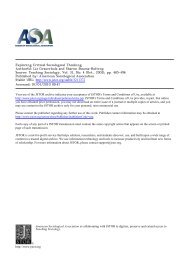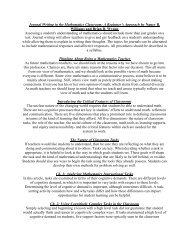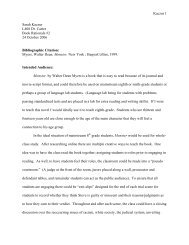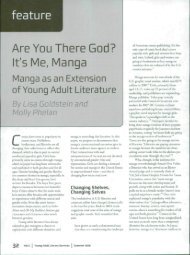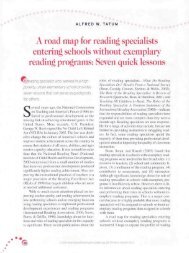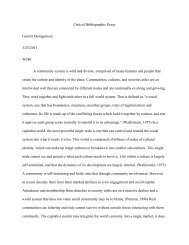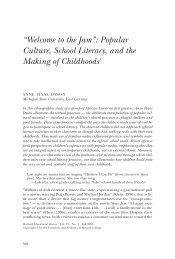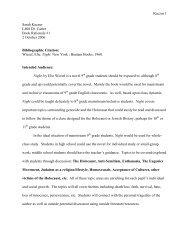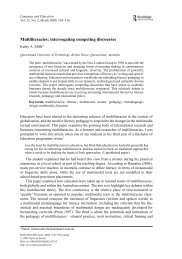McDonald 2004 Critical Reading 10-11 year olds.pdf - Oncourse
McDonald 2004 Critical Reading 10-11 year olds.pdf - Oncourse
McDonald 2004 Critical Reading 10-11 year olds.pdf - Oncourse
Create successful ePaper yourself
Turn your PDF publications into a flip-book with our unique Google optimized e-Paper software.
Literacy April <strong>2004</strong> 19<br />
Table 1: Summary of information about study class cohort<br />
Number of students 30<br />
Chronological ages<br />
<strong>10</strong>.4 to <strong>11</strong>.6 <strong>year</strong>s<br />
<strong>Reading</strong> ages n<br />
7.3 to <strong>11</strong>.9 <strong>year</strong>s<br />
Gender balance<br />
17 girls, 13 boys<br />
Language background 46% English Speaking Background (ESB)<br />
54% Non-English Speaking Background (NESB)<br />
[Lebanese 5 Italian 1<br />
Chinese 3 Egyptian 1<br />
Armenian 2 Korean 1<br />
Sri Lankan 2 Portuguese 1]<br />
Total no. of students classified as<br />
learners of English as an<br />
additional language<br />
<strong>11</strong><br />
(Source: Class teacher)<br />
n<br />
<strong>Reading</strong> ages as per the Progressive Achievement Test (A) in <strong>Reading</strong> Comprehension (ACER, 1986)<br />
whole-class level. These lessons took place at different<br />
times before lunch (1pm) and ranged from between 40<br />
and 70 minutes in length. The reading of the novel was<br />
considered a part of the ‘shared reading’ aspect of the<br />
literacy programme and the teacher placed importance<br />
on developing a community of readers (Fish, 1979)<br />
who talk about a good book together (personal<br />
communication). Some students obtained a copy of<br />
the novel and followed the teacher’s reading.<br />
A non-critical pedagogy: students’ stories<br />
In the study the teacher wanted to develop classroom<br />
talk which could be seen to construct moves towards<br />
critical reading. To achieve this, she not only paid<br />
attention to grammatical, narrative and gender perspectives<br />
in the novel (‘critical talk’) but also encouraged<br />
students’ personal stories as responses to the<br />
novel, which I have called ‘noncritical’ talk. In each of<br />
these lessons this ‘story-telling’ positioned the students<br />
to empathise with the novel’s events and the<br />
characters’ actions and reactions in relation to those<br />
events. Table 2 below presents examples of the<br />
relationship between text stimuli and the students’<br />
stories. Lessons 1 and 7 will be discussed as exemplars<br />
of a non-critical pedagogy.<br />
As Table 2 shows, the students were encouraged to<br />
align their experiences with those attributed to the<br />
characters in the novel. This deliberate foregrounding<br />
of the students’ repertoire was particularly important<br />
in Lesson 1, when the teacher (T) drew on the students’<br />
experiences of friendship to introduce the novel, as can<br />
be seen in the excerpt below. In each excerpt that<br />
follows the numbers indicate the turns taken and their<br />
place in the lesson sequence. For example, 1 T indicates<br />
that this excerpt is part of the teacher’s opening<br />
monologue:<br />
1T<br />
Now what I want you to do is think about the<br />
friends you have had since you’ve first started being<br />
conscious of the importance of a friend in your life.<br />
Let’s do a little bit of thinking. Who are the friends<br />
who have been special to you . . . Now hands up<br />
those of you who have had or have a special friend<br />
that has been part of your life for a lot of that time,<br />
lot of those <strong>year</strong>s. Yeh, many of you, ok. Could we<br />
just talk about those friends for a moment. The<br />
long-term friends, people who’ve been part of your<br />
Table 2: Examples of the relationship between the study lessons, text stimuli and students’ stories<br />
Lesson Text stimulus Story topics<br />
Lesson 1 Susie’s best friend announces she is leaving Leaving friends, or being ‘left’ when<br />
friends leave: friendship stories<br />
Lesson 7 Susie uses her mother as an ‘excuse’ to her peer Times when students have made<br />
‘excuses’ to avoid doing something<br />
Lesson <strong>10</strong> Susie’s mother takes her shopping for party clothes Improvisations of scenes based on<br />
experiences of going shopping for<br />
clothes with mum<br />
Lesson 15 The activities of the Blue Lady as artist Grandparent stories, their activities and<br />
relationships with the students<br />
r UKLA 2003



